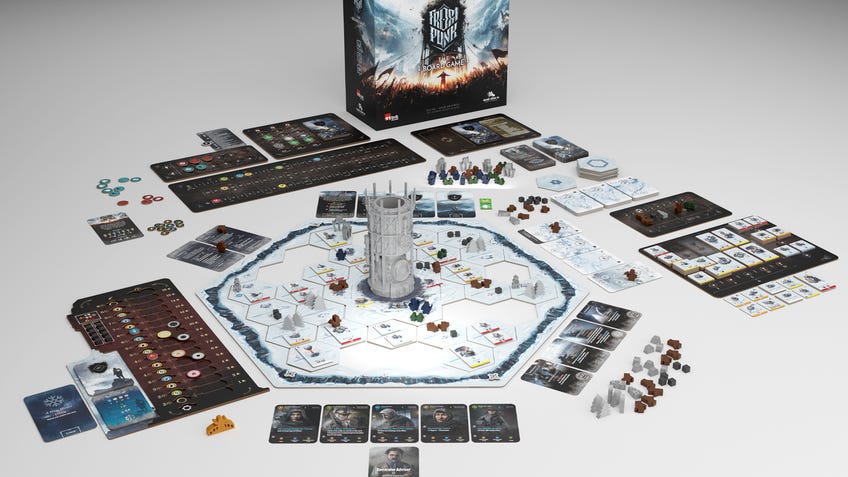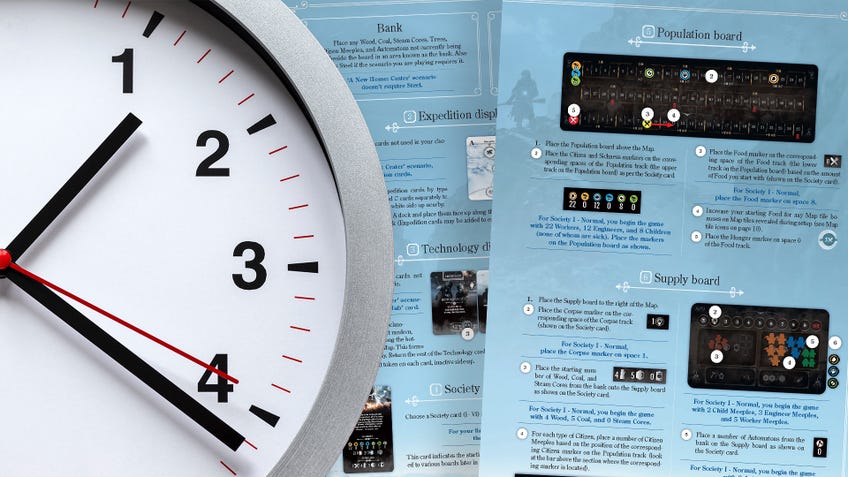I spent an hour failing to set up a board game and it made me question everything
Frozen in Frostpunk.
Frostpunk, the video game, is fantastic. Frostpunk: The Board Game might be fantastic, too. I don’t know, because I haven’t managed to play it yet.
That’s not for lack of trying, mind. Over the holidays, I broke out the Kickstarter copy sent across by publisher Glass Cannon Unplugged. I left the stretch goal expansions to the side and tore my way through the base game’s shrinkwrap like an unsurprising Christmas present.
As someone that plays a lot of board games for my job, I have no problem spending a good while popping out cardboard pieces from layer after layer of stacked punchboard. Mining my way through the crust knowing that a rich seam of gameplay lies beneath, waiting to be excavated. It’s therapeutic almost. Stick on a podcast, listen to some music, chat with friends over Discord. Pop. Pop. Pop.
Pieces extracted and arranged in neat piles, it was time to learn how to play. Excited from the teases of what I’d be doing gleaned from tiles and tokens, I snuggled into a comfy spot on the sofa and cracked open the rulebook like the latest must-read novel.
A bit of flavour text at the start of the book sets up Frostpunk’s brutally frozen world, the last scraps of humanity trying to eke out an existence in an unforgiving landscape of ice, metal and coal. It’s presumably an aperitif to whet your appetite before you embark on the fairly mundane process of actually constructing your lonely city and its surroundings on the tabletop.
I was ready. I thought of the life-or-death decisions and moral dilemmas that would be at my fingertips in a few minutes. The gripping tension of balancing my citizens’ happiness with the ruthless fight to survive. Productivity with pleasure. We might live, but what life?

I glanced at the many boards that would soon hold my victory - or failure - in sway. Quantifying resources, the vital heat provided by the generator at the heart of the city, its ebbing population - how many of my people would be healthy, sick or starving - the level of hope and contentment among society, weather, buildings, laws, social disputes, rounds, expeditions… Christ, there are quite a lot of bits in this box, aren’t there? Well, Frostpunk is a complex game on screen - replicating that properly in cardboard clearly takes a lot of moving parts. I’m sure it’ll all seem straightforward once I know how to play.
We’re in the age of blockbuster board games, where value is measured in kilos and cubic metres.
First, I need to put everything in its right place. The generator - a towering monolith of grey plastic - was erected in the middle of a hexagonal frame that would become my city’s borders. Then came instructions on placing map tiles around it. Then resource deposits on those tiles.
Next: rows of cards. Expeditions, technology, societies. Each with their own multi-step preparation. Use these in certain scenarios, leave these out in others. I diligently sort through the decks, separating things out for the first scenario.
It’s been at least an hour since I opened Frostpunk’s box. I wonder how much more setup there is to go. Population board, step five… of fourteen?! I flick ahead. It’s 18 pages before you actually start learning how to play. My poor table is already heaving under the number of components laid out. Frostpunk’s enormous footprint pushes my table space to its max; cardboard dangles precariously off the edge like diving boards. One errant elbow and multiple minutes of setup risk being undone in seconds.
I’m defeated. I question whether I’m still cut out for this. I remember endless childhood hours spent reading video game manuals in cars. Entire evenings spent memorising chunky board game rulebooks to help friends cut to the chase when we break out Twilight Imperium or Civilization over the weekend.
Often the idea of playing the next blockbuster or looking at the picture-perfect detail of its miniatures is enough to sink a hundred quid into the latest runaway crowdfunder.
Frostpunk isn’t alone in this. Too many board games have ended up overinflated by Kickstarter success, bursting at the seams with needless stretch goals, trays of miniatures and a desperate argument that more stuff is better value. We’re in the age of blockbuster board games, where value is measured in kilos and cubic metres, rather than hours, memorable turns and calls of “Let’s play that again.”
Who cares if a board game takes two hours to set up, another hour to teach and four hours to play if it’s mostly going to sit on a shelf and look good? Often the idea of playing the next blockbuster or looking at the picture-perfect detail of its miniatures is enough to sink a hundred quid into the latest runaway crowdfunder. It’s not the fault of players chasing the romantic idea of a game night, or designers working to a checklist of stretch goals and flashy components needed to make their creations a reality. It's not just games, either: movies increasingly have to be three hours long to justify a cinema ticket, while individual episodes of a Netflix series outstretch feature-length films.

I accept I’m an old man yelling at cloud servers. I find my copy of Sea Salt & Paper - a perfect 15-minute game, rules, setup and all, little bigger than a deck of cards - and hold it to bring me back. I think about Boop, one of the highlights of last year, and the way it could be set up and learnt quicker than some game titles would take to say. Then I think of Root - a board game I have spent dozens of hours playing on tables, computer and phones after a couple of hours getting my head to tick in time with its Swiss watch of a rulebook.
Not every game needs to have 20 pages of dense tutorial, just as not every game should have rules that can fit on a postcard. There’s delight and discovery in playing both hefty blockbusters piled high with plastic and cardboard, and polished gems hardened into diamonds by their reliance on little more than a handful of components and a single key mechanism.
Perhaps I’m kidding myself. After all this, I still want to play Frostpunk. Its setup defeated me once, but I cling on to the hope that the effort - when I can muster it - will ultimately be worthwhile. Call it sunk cost fallacy, professional courtesy, foolish optimism, whatever - isn’t part of the joy of tabletop gaming knowing that the effort you put into learning and running a game will be rewarded tenfold? Even so, it’ll take me a little while yet before I’m ready to carve out the time Frostpunk demands.


